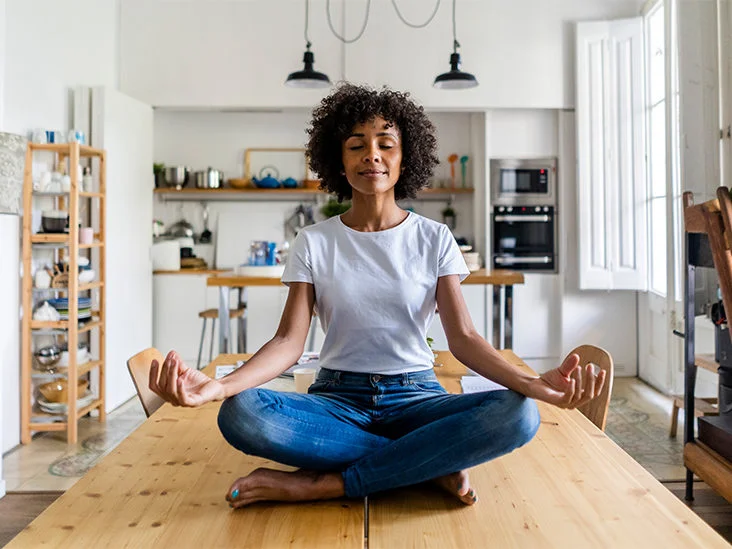Anxiety is a common problem that can affect people of all ages. While there are many different methods of treatment available, guided imagery is one option that has shown to be quite effective. This type of therapy involves using images and sounds to create peaceful and relaxing scenes. In this blog post, we will discuss the basics of guided imagery and how it can be used to help cope with anxiety.
Contents
- 1 Does Guided Imagery Help Anxiety?
- 2 How Does Guided Imagery For Anxiety Work?
- 3 What Is An Example Of Guided Imagery For Anxiety?
- 4 What Makes Guided Imagery A Power Tool For Anxiety?
- 5 What Are The Benefits Of Guided Imagery Anxiety?
- 6 Is Guided Imagery The Same As Hypnosis?
- 7 How Do I Get Started With It?
- 8 Conclusion
Does Guided Imagery Help Anxiety?
 The very short answer is yes, guided imagery can help with anxiety. Guided imagery helps to relax the body and mind by providing a way to escape from unpleasant or stressful thoughts and feelings. In addition, it can provide an avenue through which individuals can explore new ways of thinking. Or behaving that might be beneficial in reducing or eliminating certain sources of stress and anxiety.
The very short answer is yes, guided imagery can help with anxiety. Guided imagery helps to relax the body and mind by providing a way to escape from unpleasant or stressful thoughts and feelings. In addition, it can provide an avenue through which individuals can explore new ways of thinking. Or behaving that might be beneficial in reducing or eliminating certain sources of stress and anxiety.
Guided imagery is considered a form of mindfulness meditation. Mindfulness meditation is a form of self-regulation that has been shown to be beneficial in a number of ways, including reducing anxiety and stress. So, now you are aware that guided imagery can be helpful in reducing anxiety, let’s go further and discuss other essential details.
How Does Guided Imagery For Anxiety Work?
If you’re looking to reduce anxiety, guided imagery is an effective tool. Guided imagery involves the use of calming mental images and positive affirmations to help relax the mind and body. It takes advantage of the close relationship between our thoughts, feelings, and physical sensations. By using this technique, you can reduce stress and improve your overall well-being.
The process is very simple. You will be guided through a series of calming visualizations and positive affirmations. This will help you to relax your body, clear your mind, and shift into a more relaxed state. During the process, you may be asked to imagine yourself in different settings or scenarios that promote relaxation. It’s important to remain focused on the images and affirmations and not to let other thoughts distract you.
Guided imagery is a safe and effective way to reduce anxiety and stress. It can be used on its own or in combination with traditional therapies such as cognitive-behavioral therapy (CBT) or medications. When combined with other treatments, there will definitely be an increase in effectiveness. It is important to discuss the use of guided imagery with your healthcare provider if you are considering using it.
What Is An Example Of Guided Imagery For Anxiety?
There are many different methods of guided imagery for anxiety. One popular example is the peaceful place script. This script helps to create a relaxing environment and reframe anxious thoughts. The person creating the script can start by having the person close their eyes and take several deep breaths, focusing on each breath as it goes in and out.
Then, the person should imagine a peaceful place where they feel safe and content. This can be anywhere, such as a beach, a forest, or even just the person’s own bedroom or living room. The person should focus on their happy place, taking in every detail—the sights, the sounds, the smells—and allowing those details to calm them.
The person can also imagine themselves in their happy place, doing something they enjoy. This could be swimming in a pool, walking through a park, or doing anything else that brings them peace and joy. As the person focuses on this activity, they should let go of any worries or negative thoughts that enter their mind.
What Makes Guided Imagery A Power Tool For Anxiety?
As we all know how anxiety can be paralyzing and all-consuming, guided imagery is a great way to battle it. But, what is the power of guided imagery?
Guided imagery is a relaxation technique that uses visualization, images, and metaphors to relax the body and mind. It helps quietens the constant stream of worries and fears, allowing us to focus on calming images and soothing words.
When done correctly, guided imagery provides an invaluable tool for managing anxiety by helping one become more aware of their thought patterns and physical sensations. It can help to bring our attention away from anxiety-inducing thoughts by focusing on a calming image or metaphor. This helps us better manage the physical symptoms associated with anxiety, such as rapid heart rate and shortness of breath.
What Are The Benefits Of Guided Imagery Anxiety?
If you struggle with anxiety, guided imagery can be a great tool with numerous benefits. A few of the key benefits are:
1. Reducing Stress and Anxiety Levels: Guided imagery helps to relax your body and mind, reducing the levels of stress and anxiety. This relaxation can help lessen physical symptoms of anxiety such as headache, shortness of breath, muscle tension, or a racing heart.
2. Increasing Self-Awareness: It can help promote a better understanding of your thoughts and feelings, which can be beneficial for managing anxiety. It helps to bring awareness to patterns that may be causing your anxious reactions and stresses.
3. Improving Coping Mechanisms: This provides a safe space in which you can practice coping with anxiety-provoking situations. This can help you develop and practice more effective coping strategies, which you can then apply in real-life settings.
4. Developing Self-Esteem: By using guided imagery to focus on the positive aspects of your life, it can help boost your self-esteem and confidence. This makes it easier to face your challenges and gives you the strength to work towards overcoming them.
5. Enhancing Focus and Concentration: Finally, it can help increase your concentration levels, making it easier to focus on tasks at hand while ignoring distractions. This can be especially beneficial if anxiety is impacting your ability to concentrate or focus on the important things in life.
Overall, guided imagery can be a powerful and effective tool for reducing anxiety. Although it’s often used as a stand-alone technique, combining it with other forms of therapy can maximize its impact. It’s important to find a qualified practitioner if you decide to try this technique.
Is Guided Imagery The Same As Hypnosis?
 Many people assume that guided imagery and hypnosis are the same things, but this is not quite accurate.
Many people assume that guided imagery and hypnosis are the same things, but this is not quite accurate.
Guided imagery is a technique that allows you to use your imagination to create visual images in order to achieve a desired goal or mental state. Hypnosis, on the other hand, involves being put into an altered state of consciousness by a trained practitioner. And being guided through a therapeutic session to make changes in behavior or attitudes.
Although both techniques can be effective for relaxation and relieving stress, they are not the same thing. Guided imagery is typically done on one’s own, while hypnosis requires the assistance of a qualified practitioner.
Both techniques have their own unique benefits. So it is important to make a distinction between the two before deciding which one is right for you.
How Do I Get Started With It?
Well, getting started with guided imagery for anxiety is not difficult. Here are a few steps that can guide you on the right path:
- Find a quiet, comfortable place free from distractions where you can relax. This could be your bedroom, living room, or even a park bench.
- Close your eyes and take several deep breaths to help you focus and calm down.
- Visualize each part of your body and release any tension that’s held in those areas.
- Imagine a safe and peaceful environment like being on a beach or in the mountains, where you can feel relaxed and at ease.
- Use all your senses to enjoy the experience by imagining how it smells, how the air feels, what colors you see, and any sounds that you could hear.
- As your worries and fears start to drift away, focus on a mantra or phrase that will help keep you calm and centered. Repeat this mantra several times during the session.
- When you’re finished, slowly open your eyes and take a few more deep breaths.
By taking the time to practice this technique regularly, you can create positive and lasting changes in your life. Guided imagery is a great tool that can help reduce stress, manage difficult emotions, improve your outlook on life, and bring clarity and focus to any situation. Give it a try today!
Conclusion
In a nutshell, guided imagery for anxiety has been proven to be an effective treatment option. It can help to reduce the symptoms of anxiety, improve relaxation and provide a sense of control over stressful situations. Research has outlined the success rate of guided imagery for anxiety, showing that it can be a helpful way to cope with anxious feelings and thoughts. It is also relatively easy to learn and can be practiced anywhere. With practice, you may find it to be an invaluable tool in managing anxiety and stress.
For more information, please contact MantraCare. Anxiety is a feeling of fear, worry, and unease often related to an upcoming event or uncertain outcome. If you have any queries regarding Online Anxiety Counseling experienced therapists at MantraCare can help: Book a trial Anxiety therapy session


